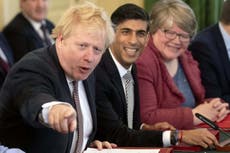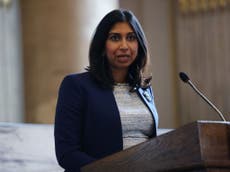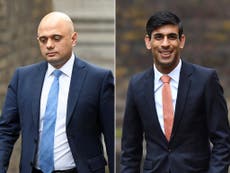Women in Johnson’s government will get nowhere as long as the power of choosing cabinet positions rests with men
Female MPs are getting pipelined then sidelined without a second thought. Unlike their male counterparts, they rarely rise up to one of the four great offices of state

All of Westminster was aflutter this week with news of the prime minister’s (or was it Dominic Cummings’?) reshuffle. Some were pushed, one jumped.
In the days before the announcement, conflicting reports emerged as to what was in store for the government’s top jobs.
One publication lauded the prime minister’s intention to “catapult” a whole “legion” of women into the cabinet; while another warned he was primed to “axe” several women.
In the end, there was definitely no catapult, nor did anyone spot a legion of women descending on No 10. And while the use of the word “axe” seems a bit extreme, we have wound up one less woman in the cabinet than previously.
The general election of 2019 saw a record number of women standing for parliament and a record number of female MPs elected; 220 of the 650 overall total in the Commons.
Women make up roughly half the population – both in the UK and globally – and yet only a third of MPs and a quarter of the cabinet are female.
The i newspaper policy editor, Jane Merrick, said it feels like “successive prime ministers [have been talking] about pipelining women through junior ministerial ranks so they can one day get to the cabinet for about 20 years”.
Former MP Cathy Jamieson pointed out that men don’t need to be “pipelined through the junior ministerial ranks” towards career success.
Just look at the meteoric rise of our brand new chancellor. Rishi Sunak followed in William Hague’s footsteps when he successfully held the seat of Richmond in Yorkshire for the Tories in October 2014; six years later, he holds the second most powerful office in the land. (Or does he? But that’s for another column, another day.)
Sunak was appointed as chief secretary to the Treasury in 2019, a position he held for all of 10 minutes in political years before being handed the keys to No 11. To be fair, he did also hold the impressively long title of parliamentary under-secretary of state at the Ministry of Housing, Communities and Local Government for 18 months before that.
Let’s take a look at Andrea Leadsom’s credentials by comparison. (I know, I know, I’d really rather not as well, but I’m trying to make a point here). She has been economic secretary to the Treasury (13 months), energy minister (14 months), environment secretary (11 months), leader of the House of Commons (11 months) and business secretary for seven months. And she was an arch-Brexiteer. But where is she? Gone.
And what about Esther McVey? She worked in various roles from parliamentary under-secretary of state for disabled people to employment minister, deputy chief whip, work and pensions secretary and housing minister. Also a fervent supporter of Brexit – adios.
Women are getting pipelined then sidelined... brought into a junior role, sometimes rising to a mid-rank role then ousted. They rarely rise up to one of the “four great offices of state”.
The United Kingdom has had two female prime ministers and three female home secretaries – but thus far, no woman has ever held the title of foreign secretary, chancellor of the exchequer – or leader of Labour party, for that matter.
The women who have risen to the pinnacle of the political profession have been held in peculiarly different regard from each other – Maggie Thatcher, the Iron Lady, was beloved of all Tories and despised by all of Labour. Theresa May, on the other hand, was seemingly hated, or at least strongly disliked, by almost everyone, and pitied by a few.
Thatcher was seen as an anomaly, the exception that proves the rule as far as women in leadership roles go. May was seen as a reason why women shouldn’t be allowed anywhere near power ever again.
Yet men aren’t labelled as proof their gender shouldn’t hold office when they move on. Their individual failure at a job isn’t used as proof that no member of their gender is equipped to hold certain roles.
May annoyed many of her Tory colleagues during her tenure as PM due to her refusal to schmooze and play the political game. She preferred, instead, to read every single word of briefing documents several times over to ensure she was fully informed of the facts before participating in a discussion or taking a decision. Thatcher operated in a similar way – on just four hours’ sleep a night apparently.
Our two women prime ministers put in the hard yards; they had to know more than anyone else in the room, to have all of the facts at their disposal in a way that did not generally apply to their male colleagues.
All because, Maggie and May knew, even just one slip-up would never be forgiven, and definitely not forgotten. They had to deliver a clear career scoresheet, free of infractions and indiscretions.
There is no “bouncing back” from a scandal seen to be caused by women MPs in the way we so often see it with men.
Probably most depressing of all is the realisation that for all the attempts that women make to ascend the political ladder, the decision to get them into the top jobs rests, for the most part, in the hands of men (general election aside).
Despite the fact there are a record 220 female MPs in the Commons now, of the Conservative party’s “thumping” majority of 364 MPs, just 87 are women.
With Boris Johnson touted to be in government for the best part of the next decade, we’re unlikely to see many more women getting anywhere near the top for a good while yet. Predictable it may be, but it is no less depressing.





Join our commenting forum
Join thought-provoking conversations, follow other Independent readers and see their replies